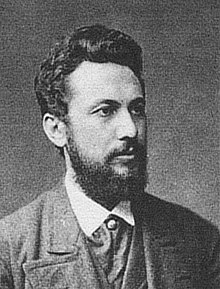Julius Peter Christian Petersen
Julius Petersen (born June 16, 1839 in Sorø , † August 5, 1910 in Copenhagen ) was a Danish mathematician . He was a pioneer in graph theory .
Life
Petersen was the son of a dyer and the family was poor. He had been friends with Hieronymus Georg Zeuthen since childhood , who at that time lived a few houses from him. Even as a schoolboy he was interested in mathematics and tried to divide the angle into three with a compass and ruler, a classic (and unsolvable) geometric problem. In 1854 he had to leave school because his family could not support him and went to an uncle in Kolding as an apprentice in a grocery store. After the death of his uncle in 1855 he inherited a little money and was able to finish school in Sorø and study at the Polytechnic in Copenhagen from 1856. In 1860 he graduated as a civil engineer, but had already published a mathematical essay in 1858. Also in 1860 he submitted an essay on the cycloid to a competition at the University of Copenhagen and won - but since he was not a student, the prize was not awarded to him. From 1859 he taught mathematics at a private school. In 1862 he passed the university entrance exam and began studying mathematics while continuing to teach and married in 1862. The marriage resulted in two sons and a daughter. In 1866 he completed his university degree in mathematics, won the university's gold medal in 1867 for a thesis on the balance of floating bodies and received his doctorate in 1871 with a thesis on the possibility of construction with compasses and ruler. In 1870/71 he corresponded with Sylow on this subject . In 1871 he became a lecturer at the Polytechnic and in 1877 professor of mathematics at the University of Copenhagen, which he remained for the rest of his career. His colleague there was his friend Zeuthen. He also taught at the military school from 1881 to 1887.
In 1891 he published a paper with which he is considered to be the pioneer of graph theory and which contained Petersen's theorem (a cubic graph without a bridge has a 1-factor).
He wrote a number of textbooks for school and university students. In 1880 Petersen published a treatise on geometric constructions with compasses and rulers (see also Classical Problems of Ancient Mathematics ), which appeared again in 1990 as a French translation.
Petersen was one of the founding members of the Danish Mathematical Society in 1873 .
Petersen discovered the first snark ( Petersen graph ) in 1898 . These are special cubic graphs whose edges cannot be colored with three colors in such a way that no two edges at a node have the same color. According to Peter Guthrie Tait , the four-color problem can be traced back to the question of the existence of planar snarks. Other snarks were first discovered in 1946 by Danilo Blanuša and then by Blanche Descartes and others.
He dealt with a wide variety of areas, in addition to geometry and graph theory, among other things, mathematical economics (he became a member of a society that dealt with political economy and which also included the well-known Danish intellectual Georg Brandes ) and cryptography (in a paper 1875, written in French) , with number theory, combinatorics (Latin squares), invariant theory (at that time a very current research area, about which he corresponded with James Joseph Sylvester and which was the reason for his occupation with graph theory), mechanics and function theory. He was on the advisory board of the insurance company Hafnia and from 1887 in the state commission for higher schools.
Fonts
- Kinematics, Copenhagen 1884
- Textbook on the dynamics of solid bodies, Copenhagen 1887
- Theory of Algebraic Equations, Copenhagen 1878
- Lectures on functional theory, Copenhagen 1898
- Methods and theories for solving geometric construction problems: applied to around 400 problems, Copenhagen 1879
Web links
- John J. O'Connor, Edmund F. Robertson : Julius Peter Christian Petersen. In: MacTutor History of Mathematics archive .
Individual evidence
- ↑ Julius Petersen : The theory of the regular graph . In: Acta Mathematica . 15, 1891, pp. 193-220. , Archives
- ↑ Sur la théorème de Tait, L'Intermédiare des Math. 5, 1898, pp. 225-227
| personal data | |
|---|---|
| SURNAME | Petersen, Julius Peter Christian |
| ALTERNATIVE NAMES | Petersen, Julius |
| BRIEF DESCRIPTION | Danish mathematician, studied graph theory |
| DATE OF BIRTH | June 6, 1839 |
| PLACE OF BIRTH | Sorø , Denmark |
| DATE OF DEATH | August 5, 1910 |
| Place of death | Copenhagen |
